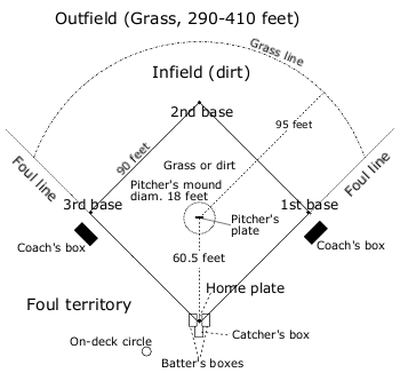Summary

If you want a Project Idea with full instructions, please pick one without an asterisk (*) at the end of the title.
Abstract
Have you ever wondered how playing in a certain stadium affects how well the athletes perform? Major League Baseball (MLB) is played in ballparks that have their own individual quirks when it comes to the exact layout of the field. How an individual ballpark affects player performance, which is known as ballpark effects, is heavily investigated in the field of baseball. To name just a few parks and their different traits, Fenway Park (the long-time home ballpark for the Boston Red Sox in Boston, Massachusetts) has the famous "Green Monster" in left field, the original Yankee Stadium (located in the Bronx in New York City) was notorious for the "short porch" down the right field line, and Coors Field (in Denver, Colorado) is at a much higher altitude than any other ballpark. How do differences likes these and others affect batting statistics?
One characteristic of a ballpark that you can use to compare it to others is the ballpark's dimensions. Figure 1 below shows a general baseball field layout. But even in modern baseball not all stadiums are the same size, and this can affect batting statistics. For example, a player who hits .300 with 30 home runs in one stadium may be a .250 hitter with 15 home runs in another ballpark.
 Image Credit: Wikimedia Commons / Public domain
Image Credit: Wikimedia Commons / Public domainDiagram of a baseball field showing home plate, the pitchers mound, first base, second base, and third base. Bases are 90 feet apart, and the pitchers mound is 60.5 feet from home plate. The diagram also includes foul lines, infield dirt, outfield grass (290-410 ft), and the grass line. Batters / catchers boxes and the on-deck circle are around and behind home plate and in foul territory.
In this mathematics science project, you will determine how the dimensions of a baseball stadium affect batting statistics. You will need to do a little digging to pull the numbers together, but a nice thing about this project is that the experiments are already done, and the data is out there waiting for you. (See the Bibliography in the Background tab for some resources to help you find this data.) For each ballpark that you are interested in investigating, find out what its dimensions are. Then look up the team's batting statistics at the home ballpark and at road ballparks over the time that they have been playing in that particular home ballpark. (Do this for their opponents as well.) After you have collected the relevant data, average the batting statistics for each team for when they played in the home ballpark or in a road ballpark. Since the average road ballpark is nearly the same as the league's average ballpark, the difference between home and road performance should be the home ballpark's effect on offense. How do the dimensions of a ballpark affect which ones are good hitter's ballparks, and which are not?
You could also investigate how other factors, such as altitude, weather, and remodeling a stadium, affect how the athletes play. While altitude is easy to quantify since it does not change, matching weather data with batting statistics may be a bit harder and may require some programming. How does changing the dimensions of an existing ballpark, which sometimes happens when a stadium is remodeled, affect the players' batting statistics? For example, the Oakland Athletics' home ballpark used to have a lot more foul ground around home plate. How do you think doing something such as shrinking foul territory around home plate affects batting statistics? To investigate an effect such as this, you could select a group of players and analyze their batting statistics before and after the remodeling. You could even look at individual players to see if there are individual variations by hitting style. To investigate this, you will have to do some research to find out when changes were made, and what the ballpark dimensions were before and after remodeling.
Bibliography
Here are a few websites that will help you start gathering data on baseball parks, teams, and players for this science project:- ESPN. (n.d.). MLB Statistics - 2012. Retrieved November 9, 2012.
- Mock, J. (n.d.). Major League Ballparks since 1900, sorted chronologically by franchise. BaseballGuru.com.. Retrieved November 9, 2012.
Ask an Expert
Careers
If you like this project, you might enjoy exploring these related careers:
Related Links
- Science Fair Project Guide
- Other Ideas Like This
- Pure Mathematics Project Ideas
- Big Data Project Ideas
- My Favorites









